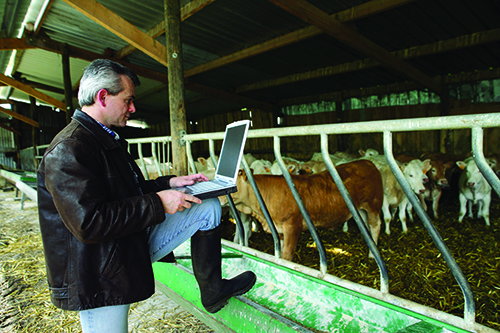Are you ready for the revolution?

 eir Business NI’s Matt McCloskey claims Northern Ireland firms could prosper from the coming Agtech Revolution.
eir Business NI’s Matt McCloskey claims Northern Ireland firms could prosper from the coming Agtech Revolution.
The rate of innovation in the agri-food industry is staggering as the sector rises to the challenge presented by the surging global population. There’s no shortage of great ideas, but amidst all this innovation, key stakeholders need to be sure they are not putting the cart before the horse. Although current attention is on the devices and applications that will lead the agtech revolution, a solid foundation is what will make or break it. eir Business NI looks at the vital role the communications network has to play in the future success of the agri-food sector.
Agri-food is Northern Ireland’s largest indigenous industry, its biggest manufacturing industry, its largest single employer and most important exporter. The sheer scale of the sector is eye-watering. It employs an estimated 100,000 people and has a proven track record for growth with sales of over £4 billion per year.
Along with the rest of the world, the agri-food sector in Northern Ireland will become ever more important. The world population is projected to reach 9.6 billion people by 2050. This presents an urgent need to increase global food production by 70 per cent.
Agri-food in the middle of a technology revolution
In response to that challenge, the agricultural sector is going through a revolution powered by technology. We’re seeing the introduction of technology into every aspect of farming, from animal reproduction to product distribution. We’re hearing a new term – agtech – to describe the technology that’s being developed for and by the agri-food sector. It is being touted as the next big area for investment firms. In a recent interview with the Irish Times, John Hartnett, founder of the Irish Technology Leadership Group said: “Once upon a time it was all about social media, now big firms are looking at agri-tech.”
And it’s not surprising. The innovation we’re seeing in this area is exceptional. The Internet of Things, coupled with smart sensors, are able to track animals’ health and deliver this data directly to the farmer, in real time. Moocall, a smart sensor that attaches to a cow’s tail can alert a farmer when a cow is about to go into labour. Smart drones equipped with GPS are being used as crop-sprayers and even in place of sheep dogs and predictive analytics – real-time data on weather, soil and air quality, and equipment – is being used to make smarter decisions. We’re also seeing sophisticated ERP software which provides access to all central data along the supply chain, ensuring transparency throughout the entire process, while demands for traceability have seen companies develop apps that allow consumers to access a product’s data via a QR code on the package.
Don’t neglect the network as a foundation for innovation
“Quite simply, the agri-food sector has become a beacon of innovation. But the risk with all of this innovation is that the underlying platform will be neglected,” warns Matt McCloskey, Sales Director at eir Business NI. “With the growth in smart applications and devices, comes an explosion in data. The ability to manage, collect, store and share this data will become paramount. The biggest impact will be on bandwidth. Imagine thousands of devices creating data on a per second basis. And then there’s the issue of datacentre capability. A robust and scalable network is arguably the most important element of the entire chain. Its job is to facilitate all of this wonderful innovation, quietly and efficiently.”
 Many in this industry aren’t techies and too many organisations in the sector are reliant on legacy networks that have been in place for years. The difficulty with these networks is that they’re based on older technology that simply doesn’t meet today’s requirements. Even those organisations that have the right IT teams in place will find themselves stretched for the skills they need to stay ahead and keep up with the growing rate of innovation.
Many in this industry aren’t techies and too many organisations in the sector are reliant on legacy networks that have been in place for years. The difficulty with these networks is that they’re based on older technology that simply doesn’t meet today’s requirements. Even those organisations that have the right IT teams in place will find themselves stretched for the skills they need to stay ahead and keep up with the growing rate of innovation.
A fully-managed network, one that’s agile enough to facilitate changing demands and growing volumes of data, will mean those IT teams in the agri-food sector can turn their focus to the technology that’s making a real difference to the business – not having to be concerned about whether the network is coping or whether all those mission-critical applications are running at their peak performance.
Sharing of data along the supply chain
Innovative technologies like sensors and robotics all generate massive amounts of data; the Moocall for example, generates 600 pieces of data per second. “You could say that data has become the lifeblood of the agri-food sector. What we’re seeing is the sheer volume of data agri-food companies are dealing with. Companies like Moy Park, for example, recently increased its output to five million chickens per week. The volume of data behind such a production facility is staggering,” says Matt.
Add in the need to produce the right food at the right time and opportunities for the continuous sharing of the right data along the supply chain become even clearer. Typically, producers won’t get an order from the retailer until the day before they want delivery. Not enough product, like chickens, means companies risk disappointing their retail partners, while excess chickens can be a massive cost to the business.
“There are so many participants and each one must work together to build on the success of Northern Ireland’s agri-food sector,” says Matt. “As Agriculture Minister Michelle O’Neill recently put it: ‘The only way to do this is by ensuring that all parts of the supply chain know what they’re supposed to be doing. This can only be achieved through enhanced two-way, continuous communication.’“
“There are obvious challenges to connecting everyone; many of the players in the agri-food sector by their nature are rural, and are often in hard-to-reach areas of the country. Therefore, the network needs to get to those hard-to-reach places too. At eir Business NI we’re constantly working on extending our next generation IP network. We now have 22 large towns across Northern Ireland on our own IP network, and we continue to work as a network aggregator, which means we can deliver high-performing, reliable connectivity to a huge proportion of the country.”
Who will be the successful players in agtech?
Much like the agri-food sector itself, which is looking ahead to the future demands on production, the successful players in the agri-food revolution will be those forward-thinking farmers, producers, processing companies and retailers, who lay a solid foundation now on which to build the future. This foundation comprises the trifecta of a robust network to carry all the additional data, a world-class data centre to store it, and a highly-skilled IT team who no longer need to worry about network performance and are free to develop innovative solutions to tackle the challenges ahead.
To discuss how your business can benefit from having the right platform for the agtech revolution, connect with Matt McCloskey at uk.linkedin.com/in/mattmccloskey





